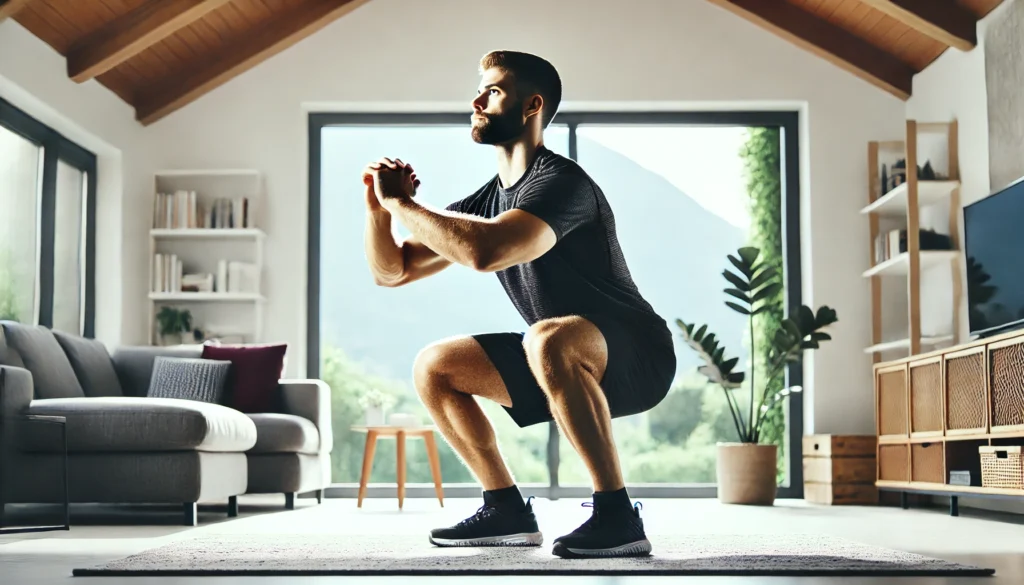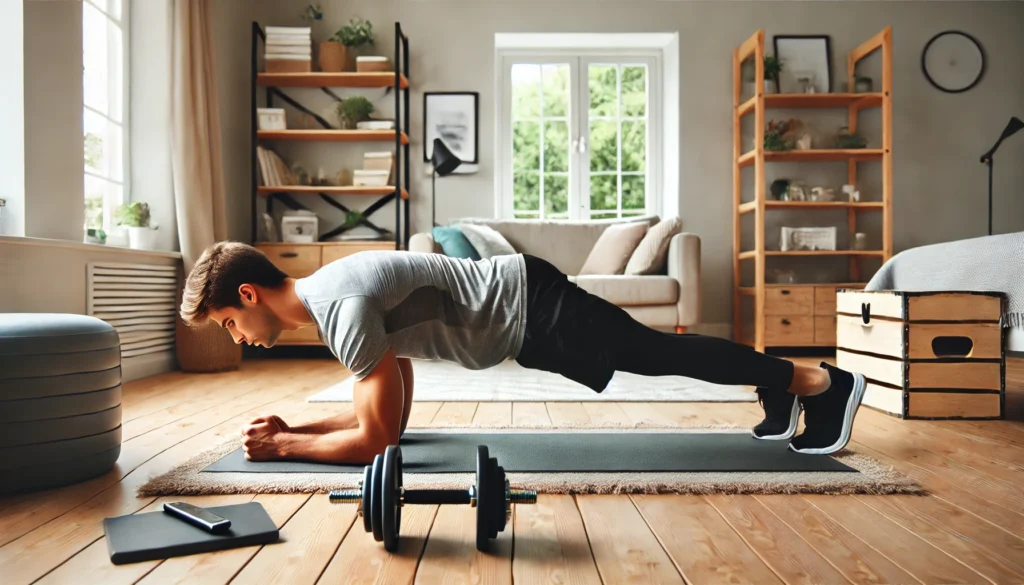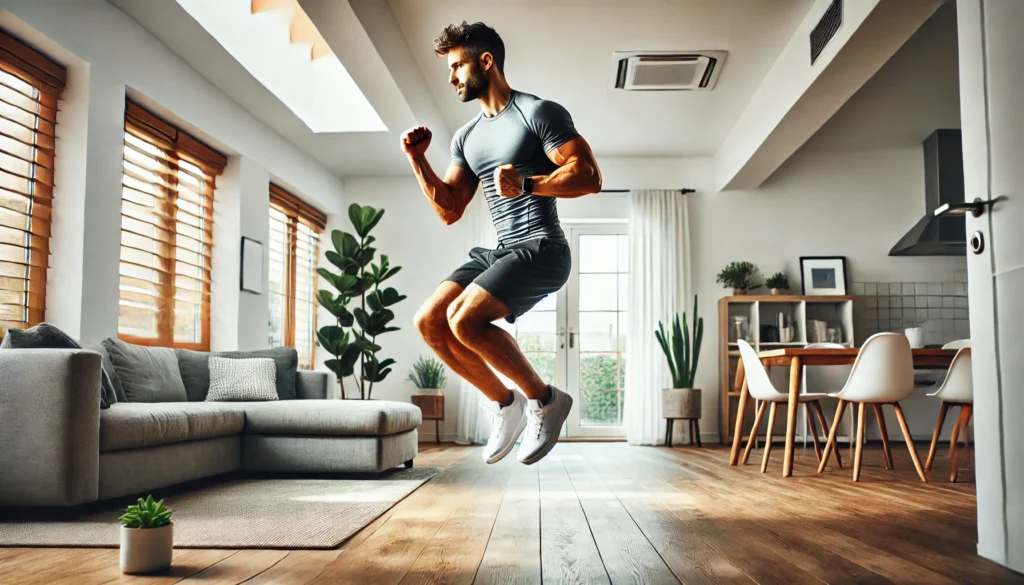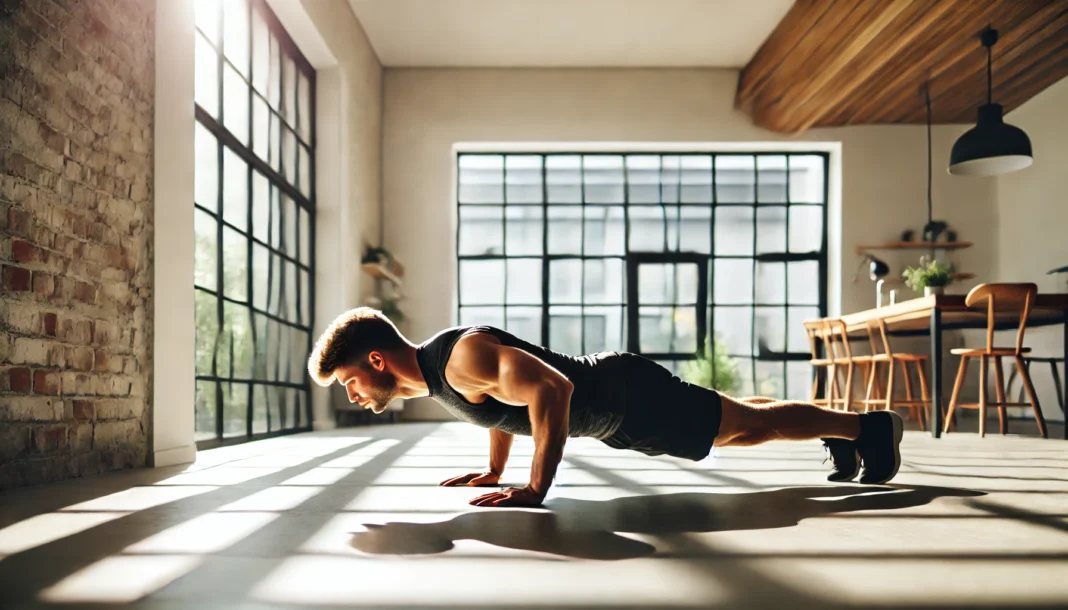Introduction: The Power of No Gear Workouts
In a world where gym memberships, machines, and high-tech fitness gadgets dominate the fitness landscape, the idea of working out without machines may seem limiting to some. However, a no gear workout can be just as effective—if not more—than traditional gym-based training. By utilizing body weight, gravity, and strategic movement patterns, individuals can develop strength, endurance, and agility without the need for expensive equipment. The key lies in understanding the science behind workout exercises without equipment and how to maximize intensity, efficiency, and variety. Whether you’re at home, traveling, or simply looking for a new challenge, a well-structured free body workout is all you need to build a powerful, resilient physique.
You may also like: The Ultimate Bodyweight Workout Routine for Full-Body Strength and Performance
Why a No Equipment Workout Full Body Workout Is So Effective
A no equipment workout full body workout is an excellent way to train multiple muscle groups while improving cardiovascular health and flexibility. Unlike machine-based exercises that isolate specific muscles, workout exercises without equipment require the body to engage stabilizing muscles, increasing overall functional strength. This type of training enhances neuromuscular coordination, allowing individuals to move more efficiently in everyday activities and athletic endeavors. Additionally, bodyweight exercises are highly adaptable, making them suitable for beginners and advanced athletes alike. By incorporating progressive overload, such as increasing repetitions, tempo, or range of motion, individuals can continuously challenge their muscles and prevent plateaus.
The Science of Working Out Without Machines
Working out without machines is rooted in biomechanics and functional fitness principles. Free movement exercises, such as push-ups, squats, and planks, mimic real-life activities, promoting better movement patterns and reducing injury risk. Unlike traditional weightlifting, which often isolates muscles, bodyweight training encourages the recruitment of multiple muscle groups simultaneously. This results in greater energy expenditure, making a no gear workout highly effective for fat loss and cardiovascular conditioning. Furthermore, performing workout exercises without equipment improves joint mobility and flexibility, key components of long-term musculoskeletal health. Understanding how to leverage one’s own body weight ensures a more balanced, sustainable approach to fitness.
Structuring the Perfect Free Body Workout Routine
A free body workout should be designed to target all major muscle groups while incorporating elements of strength, endurance, and flexibility. To maximize efficiency, it is important to structure workouts into movement-based categories: push, pull, squat, hinge, and core. Push movements, such as push-ups and dips, develop upper body strength, while pull exercises, such as inverted rows (using a sturdy table) or towel-assisted pulls, enhance back and arm development. Squats, lunges, and single-leg exercises strengthen the lower body, improving both power and stability. Core-focused exercises, such as planks, leg raises, and rotational movements, reinforce stability and prevent injuries. By combining these elements into a balanced routine, individuals can develop a well-rounded, full-body strength and endurance program.

Maximizing Intensity in a No Equipment Workout Full Body Workout
Without the ability to increase resistance through weights, maximizing intensity in a no equipment workout full body workout requires strategic modifications. Increasing time under tension—slowing down movements to emphasize muscle engagement—creates greater resistance and improves muscle endurance. Plyometric movements, such as jump squats and explosive push-ups, enhance power and elevate heart rate, making workouts more dynamic. Utilizing isometric holds, such as wall sits and static planks, develops muscular endurance and mental toughness. Additionally, modifying angles—such as performing decline push-ups or Bulgarian split squats—alters resistance and targets muscles differently. Combining these methods ensures continuous progress and challenges the body in new ways.
The Cardiovascular Benefits of Workout Exercises Without Equipment
One of the most overlooked aspects of workout exercises without equipment is their ability to improve cardiovascular endurance. High-intensity interval training (HIIT) using bodyweight movements is an effective way to enhance heart health and metabolic efficiency. Burpees, mountain climbers, and jumping jacks elevate heart rate while simultaneously building strength. Circuit-style training, where exercises are performed in succession with minimal rest, maximizes calorie burn and cardiovascular adaptation. These workouts can be easily modified based on fitness level, making them accessible to beginners while still challenging for advanced athletes. The combination of strength and endurance training within a no gear workout creates a holistic approach to fitness that yields lasting results.
The Role of Mobility and Flexibility in Working Out Without Machines
Mobility and flexibility are crucial components of working out without machines, as they support movement efficiency and injury prevention. Many individuals overlook mobility drills, leading to tightness and movement restrictions that can hinder progress. Dynamic stretches, such as leg swings and arm circles, prepare the body for movement and reduce injury risk. Post-workout static stretching, including deep lunges and hamstring stretches, improves muscle elasticity and recovery. Incorporating yoga-inspired movements, such as downward dog or spinal twists, enhances flexibility and stability. A well-rounded no equipment workout full body workout should integrate mobility work to ensure longevity and movement quality.
Overcoming Common Challenges in a No Gear Workout
While a no gear workout is highly effective, some individuals may struggle with common challenges, such as exercise boredom or perceived lack of resistance. To combat monotony, it is essential to incorporate variety through different movement patterns, workout structures, and intensity techniques. Switching between endurance-based circuits, strength-focused sets, and plyometric sequences keeps workouts engaging. Additionally, increasing repetitions, modifying tempos, and incorporating unilateral (single-arm or single-leg) exercises enhances difficulty without requiring equipment. For those seeking progression, resistance bands or weighted backpacks can be introduced gradually while still maintaining the principles of bodyweight training.
Creating a Sustainable Fitness Routine with a Free Body Workout
Long-term success in fitness requires a sustainable approach, and a free body workout provides the flexibility needed to maintain consistency. Unlike machine-based training, which often depends on gym access, bodyweight workouts can be performed anywhere, making them an ideal option for those with busy schedules or limited resources. Establishing a structured routine with clear goals—whether improving endurance, increasing strength, or enhancing flexibility—ensures continued progress. Recovery practices, such as proper sleep, hydration, and active rest days, play a critical role in sustaining a high level of performance. Emphasizing consistency over intensity guarantees lasting results and prevents burnout.

Frequently Asked Questions (FAQ) on No Gear Workouts
1. What are the advantages of a no gear workout compared to traditional gym training?
A no gear workout offers greater flexibility and accessibility, allowing individuals to exercise anywhere without the need for costly gym memberships or specialized equipment. By working out without machines, people develop greater body control, balance, and coordination, as bodyweight exercises engage stabilizing muscles often neglected by machine-based training. Additionally, a no equipment workout full body workout encourages functional movement patterns, making it more applicable to everyday activities. Since workout exercises without equipment often involve compound movements, they improve cardiovascular fitness while simultaneously building strength. Lastly, free body workouts eliminate external resistance, reducing the risk of injury associated with heavy lifting and improper machine use.
2. How can I make my no equipment workout full body workout more challenging?
To increase intensity while working out without machines, consider modifying tempo, increasing repetitions, and incorporating unilateral movements. Slowing down exercises like push-ups or squats forces muscles to remain engaged for longer, enhancing endurance and muscle activation. Progressions such as single-leg squats, one-arm push-ups, and explosive movements like jump squats or plyometric push-ups increase difficulty without requiring additional weight. Another effective approach is to decrease rest time between exercises, transforming your free body workout into a high-intensity interval training (HIIT) session. Consistently changing variables ensures continual progress and prevents workout stagnation.
3. Can I build muscle effectively with workout exercises without equipment?
Yes, building muscle with a no gear workout is entirely possible when exercises are performed with sufficient intensity and volume. The key is to use progressive overload by increasing the challenge of movements over time, such as transitioning from standard push-ups to decline push-ups or archer push-ups. Additionally, isometric holds, such as wall sits and planks, place sustained tension on muscles, promoting growth without the need for external weights. By strategically programming a no equipment workout full body workout that includes a variety of movement patterns, individuals can develop well-rounded muscular strength. The combination of high-rep endurance exercises and explosive plyometrics ensures comprehensive muscle development.
4. How does working out without machines benefit long-term health?
Engaging in workout exercises without equipment supports joint health, mobility, and functional strength, reducing the risk of age-related muscle loss and movement dysfunction. Since free body workouts promote full-body coordination and flexibility, they enhance posture and balance, preventing injuries related to poor movement mechanics. Without the reliance on machines that guide motion, individuals learn to stabilize and control their own body weight, which strengthens ligaments and tendons. Additionally, no gear workouts improve cardiovascular endurance by incorporating dynamic movements like burpees, jump squats, and mountain climbers. Over time, these workouts foster longevity by keeping the body agile and capable of handling everyday physical demands.
5. What are the best workout exercises without equipment for a beginner?
Beginners should start with foundational movements that build strength, endurance, and coordination before progressing to advanced variations. Squats, lunges, push-ups, and planks are excellent choices for a no equipment workout full body workout, as they engage multiple muscle groups. Incorporating modified versions, such as knee push-ups or assisted squats using a wall for support, helps develop confidence while reducing strain. Dynamic movements like jumping jacks or high knees provide an element of cardiovascular conditioning while remaining low-impact. As proficiency increases, individuals can integrate more complex workout exercises without equipment, such as single-leg squats or plank variations, to further enhance strength and stability.
6. How can I structure a well-balanced free body workout routine?
A well-balanced no gear workout should incorporate push, pull, squat, hinge, and core movements to ensure full-body development. Structuring workouts into circuits or supersets maximizes efficiency, keeping intensity high while reducing overall workout duration. For example, a session could include squats, push-ups, lunges, planks, and a cardio element like burpees, performed back-to-back for multiple rounds. Varying workout intensity across different sessions—some focusing on endurance, others on strength or explosiveness—ensures well-rounded fitness progression. Additionally, incorporating mobility drills and stretching improves movement quality and prevents imbalances over time.
7. Are no gear workouts effective for fat loss?
Absolutely—workout exercises without equipment can be highly effective for fat loss when structured with intensity and minimal rest. A no equipment workout full body workout that incorporates HIIT or circuit training elevates heart rate, maximizing calorie burn during and after the workout. High-intensity bodyweight movements like jump squats, mountain climbers, and burpees accelerate metabolism, promoting fat oxidation throughout the day. Additionally, compound movements that recruit multiple muscle groups require more energy expenditure, leading to higher caloric burn compared to isolated exercises. Consistency, combined with a proper nutrition plan, ensures that no gear workouts contribute effectively to long-term fat loss.
8. How do free body workouts improve athletic performance?
Free body workouts enhance agility, speed, and coordination by emphasizing natural movement patterns and full-body engagement. Many sports require explosive power and endurance, which can be developed through plyometric exercises such as squat jumps, bounding lunges, and push-up variations. Working out without machines allows for unrestricted movement, improving proprioception and body awareness—essential skills for athletic performance. Functional training elements in a no gear workout mimic real-world movements, improving an athlete’s ability to generate power, absorb impact, and change direction efficiently. By focusing on movement efficiency rather than isolated strength, bodyweight training fosters well-rounded athletic capabilities.
9. What are the most common mistakes people make in a no gear workout?
One of the most common mistakes in a no gear workout is neglecting progression, leading to plateaus in strength and endurance development. Relying on the same routine without increasing intensity, repetitions, or exercise variations can stall progress. Additionally, poor form—such as improper squat depth or arching the lower back in push-ups—can lead to muscle imbalances and potential injuries. Skipping warm-ups and mobility work reduces workout efficiency and increases the risk of strain. Lastly, failing to incorporate variety in movement patterns limits overall functional fitness, making it essential to integrate different planes of motion and dynamic exercises.
10. How can I stay motivated while working out without machines?
Staying motivated in a no equipment workout full body workout requires setting clear goals, tracking progress, and incorporating variety to maintain engagement. Setting small milestones, such as achieving a certain number of push-ups or holding a plank for longer, keeps motivation high. Rotating workout structures, trying new movement combinations, and engaging in challenges like AMRAP (as many reps as possible) sessions add excitement to workouts. Partner workouts, virtual fitness communities, or fitness tracking apps can provide external accountability and encouragement. Ultimately, focusing on performance improvements rather than aesthetics ensures long-term commitment to a sustainable free body workout routine.

Conclusion: Unlocking the Potential of a No Gear Workout
A no gear workout proves that fitness does not require expensive equipment or access to a gym. By leveraging bodyweight exercises and functional movement patterns, individuals can develop strength, endurance, and mobility in a highly effective and sustainable manner. Whether working out without machines by choice or necessity, understanding the principles of progressive overload, movement variety, and intensity modulation ensures continued improvement. A no equipment workout full body workout fosters not only physical transformation but also mental resilience, as it challenges the body in ways that promote adaptability and control. With the right mindset and structured approach, anyone can unlock their fitness potential through the power of bodyweight training.
bodyweight strength training, functional fitness, endurance workouts, calisthenics routine, home fitness, movement efficiency, progressive overload, mobility drills, plyometric training, flexibility and strength, high-intensity bodyweight training, fitness without equipment, sustainable fitness strategies, dynamic movement training, fat loss workouts, time-efficient fitness, core stability, natural movement patterns, bodyweight circuit training, holistic fitness approach.
Further Reading:
15 Best No-Equipment Full-Body Exercises You Can Do at Home
Full-Body Home Workout Plan for Beginners – No Equipment
Ultimate No-Equipment Workout Guide
Important Note: The content provided by HealthXWire is for informational purposes only and should not be construed as medical advice, diagnosis, or treatment. While we strive for accuracy, the information presented on this site may not reflect the most current research or medical guidelines. Always seek the advice of your physician or other qualified health provider with any questions you may have regarding a medical condition. HealthXWire does not endorse, recommend, or guarantee the efficacy of any products, services, or treatments mentioned on this site. Users should not disregard professional medical advice or delay seeking it because of something they have read on HealthXWire. HealthXWire is not liable for any damages, loss, or injury arising from reliance on the information provided herein.



